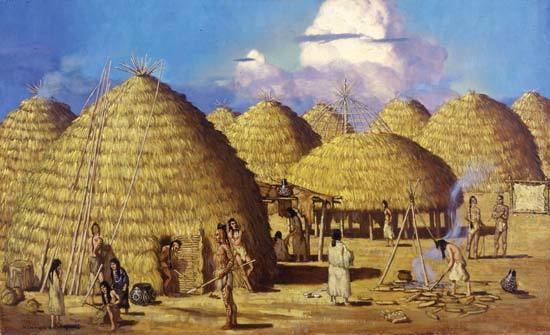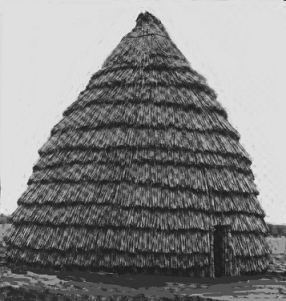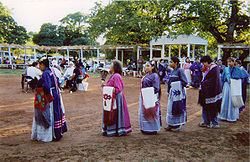 | ||
Caddo virtual field trip
The Caddo Nation is a confederacy of several Southeastern Native American tribes. Their ancestors historically inhabited much of what is now East Texas, Louisiana, and portions of southern Arkansas and Oklahoma. In the early 19th century, Caddo people were forced to a reservation in Texas, then removed to Indian Territory in 1859.
Contents
- Caddo virtual field trip
- eu4 the extremely overpowered tribe of caddo
- Government and civic institutions
- Archaeology
- Oral history
- Territory
- Post contact history
- Late 19th century to present
- 21st century tribal issues
- Notable Caddo
- References

Today, the Caddo Nation of Oklahoma is a federally recognized tribe with its capital at Binger, Oklahoma. Descendants of the historic Caddo tribes with documentation of at least 1/16 ancestry are eligible to enroll as members in the Caddo Nation. The several Caddo languages have converged into a single language.

eu4 the extremely overpowered tribe of caddo
Government and civic institutions

The Caddo Nation was previously known as the Caddo Tribe of Oklahoma. The tribal constitution provides for election of an eight-person council, with a chairperson, based in Binger, Oklahoma. The tribe operates its own housing authority and issues its own tribal vehicle tags. It operates an administrative center, dance grounds, several community centers, the Caddo Nation Heritage Museum, and an active NAGPRA office, located south of Binger. As of 2012, 5,757 people are enrolled in the nation, with 3,044 living within the state of Oklahoma.

The tribe has several programs to invigorate Caddo culture. It sponsors a summer culture camp for children. The Hasinai Society and Caddo Culture Club both teach and perform Caddo songs and dances to keep the tradition alive and passed on to the next generations. The Kiwat Hasinay Foundation is dedicated to preserving and increasing use of the Caddo language.
Archaeology
The Caddo are thought to be an extension of Woodland period peoples, the Fourche Maline and Mossy Grove cultures, whose members were living in the area of Arkansas, Louisiana, Oklahoma, and Texas between 200 BCE and 800 CE. The Wichita and Pawnee are related to the Caddo, as both tribes speak Caddoan languages.
By 800 CE, this society had begun to coalesce into the Caddoan Mississippian culture. Some villages began to gain prominence as ritual centers, where major earthworks were built, serving as temple mounds and elite residences. The mounds were arranged around leveled, large, open plazas, which were usually kept swept clean and were often used for ceremonial occasions. As complex religious and social ideas developed, some people and family lineages gained prominence over others. By 1000 CE, a society that is defined by archaeologists as "Caddoan" had emerged. By 1200, the many villages, hamlets, and farmsteads established throughout the Caddo world had developed extensive maize agriculture, producing a surplus that allowed for greater density of settlement. In these villages, artisans and craftsmen developed specialties. The artistic skills and earthwork mound-building of the Caddoan Mississippians flourished during the 12th and 13th centuries.
The Spiro Mounds, near the Arkansas River in present-day southeastern Oklahoma, were some of the most elaborate mounds in the United States. They were made by Mississippian ancestors of the historic Caddo and Wichita tribes, in what is considered the westernmost point of the Mississippian culture. The Caddo were farmers and enjoyed good growing conditions most of the time. The Piney Woods, the geographic area where they lived, was affected by the Great Drought from 1276–1299 CE, which covered an area extending to present-day California and disrupted many Native American cultures.
Archeological evidence has confirmed that the cultural continuity is unbroken from prehistory to the present among these peoples. The Caddoan Mississippian people were the direct ancestors of the historic Caddo and related Caddo language speakers who encountered the first Europeans, as well as of the modern Caddo Nation of Oklahoma.
Oral history
Caddo oral history of their creation story says the tribe emerged from an underground cave, called Chahkanina or "the place of crying," located at the confluence of the Red River of the South and Mississippi Rivers in northern present-day Louisiana. Their leader, named Moon, instructed the people not to look back. An old Caddo man carried with him a drum, a pipe, and fire, all of which continued to be important religious items to the people. His wife carried corn and pumpkin seeds. As people and accompanying animals emerged, the wolf looked back, and the exit from the underground closed to the remaining people and animals.
The Caddo peoples moved west along the Red River, which they called Bah'hatteno in Caddo. A Caddo woman, Zacado, instructed the tribe in hunting, fishing, home construction, and making clothing. Caddo religion focuses on Kadhi háyuh, translating to "Lord Above" or "Lord of the Sky." In early times, the people were led by priests, including a head priest, the xinesi, who could commune with spirits residing near Caddo temples. A cycle of ceremonies corresponded to corn cultivation. Tobacco was and is used ceremonially. Early priests drank a purifying sacrament made of wild olive leaves.
Territory
Centuries before extensive European contact, some of the Caddo territory was invaded by migrating Deghiha Siouan-speaking peoples, Osage, Ponca, Omaha, and Kaw, who moved west beginning about 1200 CE due to years of warfare with the Iroquois in the Ohio River area of present-day Kentucky. The Iroquois took control of hunting grounds in the area. The Osage particularly fought the Caddo, pushed them out of some former territory, and became dominant in the region of present-day Missouri, Arkansas, and western Kansas. These tribes had become settled in their new territory west of the Mississippi prior to mid-18th-century European contact.
Most of the Caddo historically lived in the Piney Woods ecoregion of the United States, divided among the state regions of East Texas, southern Arkansas, western Louisiana, and southeastern Oklahoma. This region extends up to the foothills of the Ozark Mountains. The Piney Woods are a dense forest of deciduous and conifer flora covering rolling hills, steep river valleys, and intermittent wetlands called bayous. Caddo people primarily settled near the Caddo River.
When they first encountered Europeans and Africans, the Caddo tribes organized themselves in three confederacies: the Natchitoches, Hasinai, and Kadohadacho. They were loosely affiliated with other neighboring tribes. The Natchitoches lived in now northern Louisiana, the Haisinai lived in East Texas, and the Kadohadacho lived near the border of Texas, Oklahoma, and Arkansas.
The Caddo people had a diet based on cultivated crops, particularly maize (corn), but also sunflower, pumpkins, and squash. These foods held with cultural significance, as did wild turkeys. They hunted and gathered wild plants, as well.
Post-contact history
The Caddo first encountered Europeans and Africans in 1541 when the Hernando de Soto Expedition came through their lands. De Soto's force had a violent clash with one band of Caddo Indians, the Tula, near present-day Caddo Gap, Arkansas. This historic event has been marked by the town with a monument.
French explorers in the early 18th century encountered the Natchitoche in northern Louisiana. They were followed by fur traders from outposts along the Gulf Coast, and later by missionaries from France and Spain, who also traveled among the people. The Europeans carried chronic infectious diseases, such as smallpox and measles, because these were endemic in their societies. As the Caddo peoples had no acquired immunity to such new diseases, they suffered epidemics with high fatalities that decimated the tribal populations. Influenza and malaria also devastated the Caddo.
French traders built forts with trading posts near Caddo villages. These stations attracted more French and other European settlers. Among such settlements are the present-day communities of Elysian Fields, and Nacogdoches, Texas, and Natchitoches, Louisiana. In the latter two towns, early explorers and settlers kept the original Caddo names of the villages.
Having given way over years before the power of the former Ohio Valley tribes, the later Caddo negotiated for peace with waves of Spanish, French, and finally Anglo-American settlers. After the 1803 Louisiana Purchase, by which the United States took over the former French colonial territory west of the Mississippi River, the US government sought to ally with the Caddo peoples. During the War of 1812, American generals such as William Henry Harrison, William Clark (explorer), and Andrew Jackson crushed pro-British uprisings among other Southeast Indians. Due to the Caddo's neutrality and their importance as a source of information for the Louisiana Territory government, they were left alone. In the 1830s, the federal government embarked on a program of Indian removal from southeast areas desired for European-American settlement, as migrants pressed from the east.
In 1835 the Kadohadacho, the northernmost Caddo confederacy, signed a treaty with the US to relocate to Mexico (in the area of present-day East Texas). Then lightly settled by Mexican colonists, this area was being rapidly transformed by greatly increased immigration of European Americans. In 1836, the Americans declared independence from Mexico and established the Republic of Texas, an independent nation. The name "Texas" is derived from the Hasinai word táysha, meaning "friend".
In 1845, Texas was admitted to the US as a state. At that time, the federal government forced the relocation of both the Hasinai and the Kadohadacho onto the Brazos Reservation. In 1859, many of the Caddo were relocated again to Indian Territory north of Texas, in present-day Oklahoma. After the Civil War, the Caddo were concentrated on a reservation located between the Washita and Canadian Rivers in Indian Territory.
In the late 19th century, the Caddo took up the Ghost Dance religion, which was widespread among American Indian nations in the West. John Wilson, a Caddo-Delaware medicine man who spoke only Caddo, was an influential leader in the Ghost Dance. In 1880, Wilson became a peyote roadman. The tribe had known the Half Moon peyote ceremony, but Wilson introduced the Big Moon ceremony to them. The Caddo tribe remains very active in the Native American Church today.
Late 19th century to present
Congress passed the Dawes Act to promote assimilation of tribes in Indian Territory. It authorized distribution of tribal communal landholdings into allotments for individual households to have them establish subsistence family farms along the European-American model. Any tribal lands remaining after such allotments were to be declared "surplus" and sold, including to non-Native Americans. The allotment system was intended to extinguish tribal Native American land claims to enable admission of Oklahoma as a state and assimilate Native Americans into majority culture. At the same time, tribal governments were to be ended. The territory had already been settled by numerous European Americans outside the tribal territories.
The Caddo vigorously opposed allotment. Whitebread, a Caddo leader, said, "because of their peaceful lives and friendship to the white man, and through their ignorance were not consulted, and have been ignored and stuck away in a corner and allowed to exist by sufferance." Tribal governments were dismantled at this time, and Native Americans were expected to act as state and US citizens. After some period, the adverse effects of these changes were recognized, as Caddo and other Native Americans suffered greatly from the disruption of the loss of their lands and breakup of their traditional cultures.
Under the federal Indian Reorganization Act of 1934 and the Oklahoma Indian Welfare Act of 1936, the Caddo restored their tribal government. They adopted a written constitution and a process of electing officials. They organized in 1938 as the Caddo Indian Tribe of Oklahoma. They ratified their constitution on 17 January 1938. In 1976, they drafted a new constitution, which continues elected representative government. During the 20th century, Caddo leaders such as Melford Williams, Harry Guy, Hubert Halfmoon, and Vernon Hunter have helped shape the tribe.
In a special election on 29 June 2002, the tribe adopted six amendments to the constitution. Tribal enrollment is open to individuals with a documented minimum of 1/16 degree Caddo blood quantum.
21st-century tribal issues
Sometimes, severe disagreements have developed among factions of the tribe that have not been resolved in elections. In August 2013, a group led by Philip Smith attempted to recall Brenda Shemayme Edwards, the chairman of the Tribal Council. This faction conducted a new election, but the victor stepped down, and Edwards refused to leave office. In October 2013, Smith and his supporters broke into the Caddo Nation headquarters. They chained the front doors from the inside and blocked off the entrance to the administration building. The opposition called the Bureau of Indian Affairs Police.
Operation of the tribe was split between two factions. The Court of Indian Offenses, which had been overseeing issues for a year because of the internal conflict, in October 2014, ordered a new election for all positions.
In the January 2015 elections, all the top tribal positions were won by women: Tamara Michele Francis as chair, Carol D. Ross as vice chair, Jennifer Reeder as secretary, and Wildena G. Moffer as treasurer.
